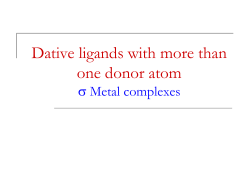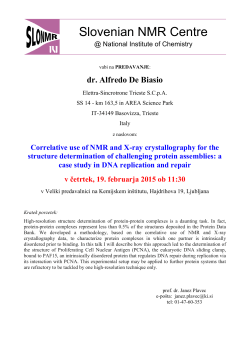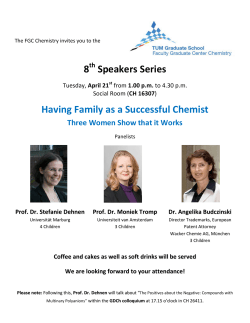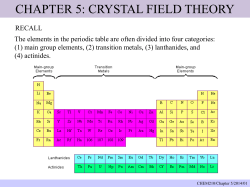
Preface - Wiley Online Library
PREFACE TO VOLUME 84 Of the 17 chapters published in the Organic Reactions series since the diamond anniversary Volume 75 (2011), nine have involved transition-metal-catalyzed transformations! The impact of catalysis using transition-metal complexes and reagents on the practice of synthetic organic chemistry cannot be overstated and continues to grow exponentially. In keeping with this remarkable trend, the two chapters in Volume 84 describe transition metal catalyzed processes that form carbon-carbon bonds and carbon-oxygen bonds in very interesting and practical ways. The first chapter authored by Christina Moberg describes an important subset of one of the earliest and most important enantioselective carbon-carbon bond forming reactions that employ transition-metal complexes, namely molybdenum-catalyzed, asymmetric allylic alkylations. Although allylic alkylation can be effected by complexes based on at least nine different metals, the field has been dominated by palladium catalysts. However, control over the site selectivity in allylic alkylation is critical to create new stereogenic centers and molybdenum-based catalysts were the first to show a high degree of selectivity for the construction of the branched isomer. Moreover, the molybdenum-catalyzed processes also diverged from the palladiumcatalyzed reactions in the mechanistic details that influence the stereochemical course of the alkylation. Professor Moberg has expertly distilled the complexities of site- and stereoselectivities into a clear presentation of the factors that are critical in choosing the appropriate variables (ligand, nucleophile, leaving group, solvent) to achieve a desired outcome. Even difficult-to-form quaternary stereogenic centers can be constructed using this method. Illustrations of applications to the synthesis of natural products and pharmaceutically active substances demonstrate the utility of the process. In view of the low cost of molybdenum precursors, this method is likely to attract interest in large-scale preparations of complex targets. The second chapter authored by Brian W. Michel, Laura D. Steffens, and Matthew S. Sigman deals with one of the oldest examples of transition-metal-catalyzed oxidation, known as the Wacker process. First documented in 1894, this transformation was developed into an industrially significant method for the conversion of ethylene into acetaldehyde by Wacker Chemie in the middle of the 20th century. Since that time, the use of the Wacker oxidation for the synthesis of carbonyl compounds from alkenes has expanded enormously. Using their expertise in the chemistry of palladium(II), Sigman and his coauthors have provided a thorough and scholarly presentation of an extremely useful but mechanistically complex process. Although the basic reaction employs palladium(II) salts in catalytic quantities along with co-catalytic amounts of copper(II) salts with molecular oxygen as the stoichiometric oxidant, the number of different solvents, oxidants, and substrates is very large, thus making the choice of optimal reaction conditions challenging. Moreover, the mechanistic details are also highly dependent on these variables, further complicating the implementation of the vii viii PREFACE TO VOLUME 84 reaction for synthesis. Fortunately, the chapter provides clear guidelines for the choice of reagent combinations to effect various oxidations along with the functional-group compatibility of those conditions. Of particular recent interest are the Wacker-type reactions that do not generate carbonyl compounds. These transformations allow for the functionalization of alkenes to form ethers, amines, acetals, and other heteroatomic assemblies. The ease of operation and significant synthetic potential of the products assures that the transformations in this chapter will continue to find widespread use in academic and industrial laboratories alike. It is appropriate here to acknowledge the expert assistance of the entire editorial board, in particular, Steven Weinreb who shepherded the Sigman chapter to completion. The contributions of the authors, editors, and the publisher were expertly coordinated by the responsible secretary, Jeffery Press. In addition, the Organic Reactions enterprise could not maintain the quality of production without the dedicated efforts of its editorial staff, Dr. Linda S. Press, Dr. Danielle Soenen, and Dr. Dena Lindsay. Insofar as the essence of Organic Reactions chapters resides in the massive tables of examples, the authors’ and editorial coordinator’s painstaking efforts are highly prized. Scott E. Denmark Urbana, Illinois
© Copyright 2025












